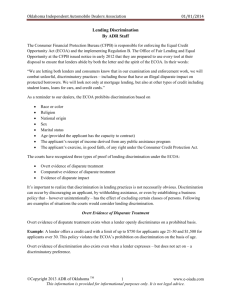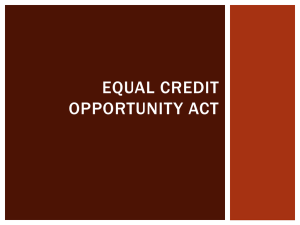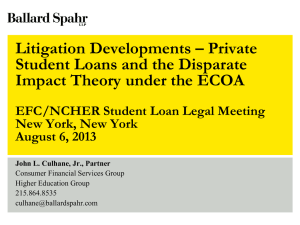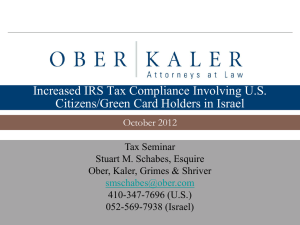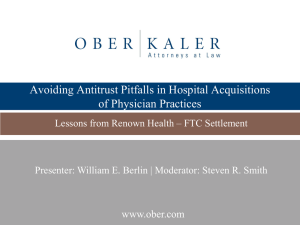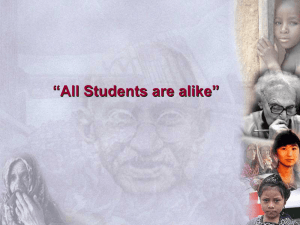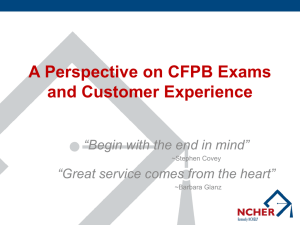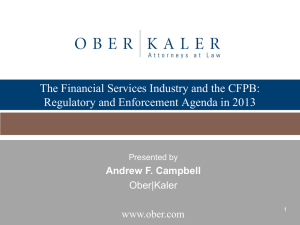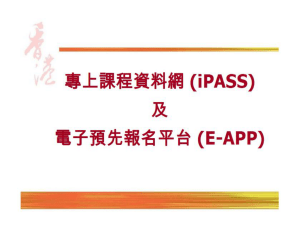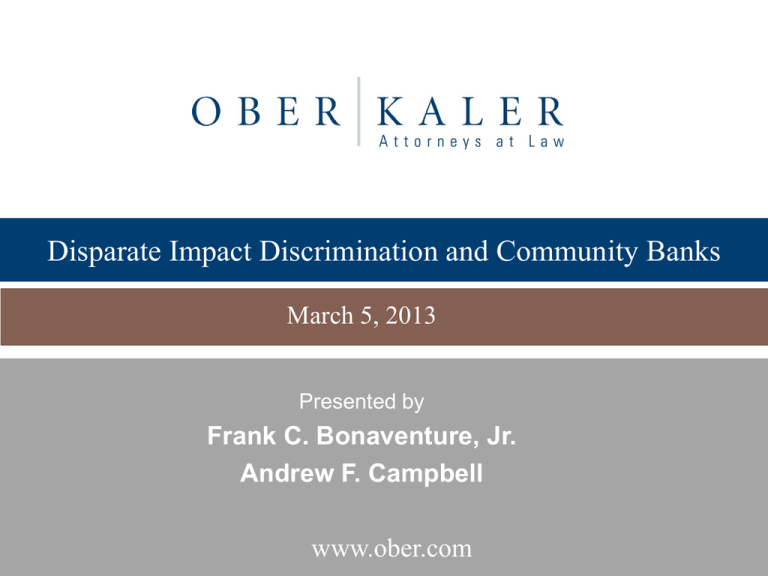
Disparate Impact Discrimination and Community Banks
March 5, 2013
Presented by
Frank C. Bonaventure, Jr.
Andrew F. Campbell
www.ober.com
Introduction
What is disparate impact discrimination?
Why is it especially important now?
What should you do to protect your institution?
1
www.ober.com
Prohibited Bases under ECOA and FHA
Equal Credit Opportunity Act
Fair Housing Act
race or color
race or color
religion
religion
national origin
sex
sex
handicap
marital status
familial status
age
national origin
applicant receives public
assistance
applicant exercises a right
under the Consumer
Credit Protection Act
2
www.ober.com
Covered Transactions
ECOA – All aspects of a credit
transaction for consumer and
commercial loans
Applications
Customer assistance during
the application process
Underwriting
Servicing
Collections
FHA –
Loans to purchase,
construct, improve,
repair, or maintain a
dwelling
The sale or rental of
housing
brokering or
appraising residential
real property
May apply to assignees
under certain circumstances
May also cover real estate
brokers, automobile dealers,
home builders, and homeimprovement contractors
3
www.ober.com
Types of Discrimination
1994 Policy Statement issued by 11 Federal
agencies outlined 3 types of discrimination
Overt Discrimination
Disparate Treatment
Disparate Impact
4
www.ober.com
Overt and Disparate Treatment
Overt Discrimination – Examples
Credit Offer – lender offers a credit card with a limit of up to $750 for applicants
age 21–30 and $1,500 for applicants over 30.
Fees and Pricing – lender charges minority applicants a higher application fee
than it charges non-minority applicants, and loans that it makes to minority
applicants carry interest rates that are 2 to 3 points higher than loans made to
non-minority borrowers with similar credit profiles.
Disparate Treatment – occurs when a lender treats a credit applicant differently on
the basis of one of the prohibited factors
Different levels of effort and assistance to applicants
Offering different products and services
Redlining – an example of a non-neutral policy
5
www.ober.com
Disparate Impact Discrimination
Disparate impact. A disparate impact occurs when a lender applies a neutral policy or
practice equally to all credit applicants but the effect of the policy or practice can be
shown by statistical analysis to disproportionately exclude or burden applicants on a
prohibited basis.
Example
A lender’s policy is to deny loan applications for single-family residences for less
than $60,000. The policy has been in effect for ten years. This minimum loan
amount policy is shown to disproportionately exclude potential minority applicants
from consideration because of their income levels or the value of the houses in the
areas where they live.
Generally, if a borrower can show that a lender’s policy has a statistically significant
disparate impact on a protected class, the lender then must show that the policy or
practice is justified by a business necessity and that there is not a readily available
non-discriminatory alternative that would accomplish the same purpose.
6
www.ober.com
Recent Disparate Impact Cases
Disparate impact cases have typically involved neutral policies that result in higher
prices and fees for individuals protected by ECOA and FHA
Countrywide – policy gave loan officers and mortgage brokers discretion over
interest rate and fees. Statistical analysis allegedly showed that over 200,000
African-American and Hispanic borrowers were charged higher fees and interest
rates and were steered into subprime loans. $335 million settlement is the largest
in history.
Wells Fargo – mortgage brokers were given pricing discretion; statistical analysis
allegedly showed that African-Americans and Hispanic borrowers in the Chicago
area were charged an average of $2,937 and $2,187, respectively, than
nonminority applicants with the same credit profile. Wells Fargo settled to avoid a
costly legal battle.
SunTrust - loan officers and mortgage brokers in SunTrust’s 200 retail offices were
allowed to vary a loan’s interest rate and other fees from the price it set based on
the borrower’s objective credit-related factors. DOJ’s investigation lasted 2 ½
years and analyzed more than 850,000 loans originated between 2005 and 2009.
7
www.ober.com
Other Disparate Impact Scenarios
Most recent ECOA cases involve discretionary pricing policies
Other uses of subjective, rather than objective, criteria in the loan approval
process, e.g.,
Loan Committee
Analyses of business plans
Steering
Establishment of interest reserves and other conditions to approval
Loan minimums
Geographical grading systems
Collections
(FHA) –
mobile home occupancy limits
Land use, zoning, and withdrawal from the Section 8 program
8
www.ober.com
Heightened Regulatory Attention
Consumer Financial Protection Bureau
Disparate Impact Analysis in Fair lending Cases
CFPB Bulletin 2012-04 (Fair Lending) (April 18, 2012)
Fully embraces the use of disparate impact analysis in lending discrimination
cases
December 6, 2012 Memorandum of Understanding with the Department of Justice
for information sharing and joint enforcement; coordination with DOJ on
enforcement priorities
Active participation in Federal Financial Fraud Enforcement Task Force’s NonDiscrimination Working Group and Federal Interagency Task Force on Fair
Lending with bank regulators
Data-driven examination procedures
State of the art consumer complaint system
Fair lending staff member assigned to each examination of banks and non-banks
9
www.ober.com
CFPB Enforcement
“CFPB’s Fair Lending and Enforcement offices have a number of pending fair lending
investigations, including matters arising from the CFPB’s supervisory activity and joint
investigations with other federal agencies. While the details of ongoing investigations
are confidential, the CFPB’s conclusions will typically be made public if an
enforcement action is filed at the conclusion of an investigation.”
Fair Lending Report of the Consumer Financial Protection Bureau (December 2012)
Next area of enforcement may be discretionary pricing by auto dealerships
involved in originating auto loans
CFPB has shown a willingness to set new universally applicable policy through
enforcement action
“Tornado” approach to enforcement gives defendants little choice but to enter into
settlements
10
www.ober.com
HUD
On February 8, 2013, issued a Final Rule formalizing “HUD’s long-held interpretation
of the availability of [disparate impact] liability under the Fair Housing Act.” 78 Fed.
Reg. 11460 (Feb. 15, 2013)
formally establishes the three-part burden-shifting test currently used by HUD and
some federal courts
Fair Housing Act is violated by facially neutral practices that have an unjustified
discriminatory effect on the basis of a protected characteristic, regardless of intent
makes clear that a lender’s facially neutral policy allowing employees and
mortgage brokers the discretion to price loans may be actionable under the Fair
Housing Act
does not explain the degree to which a practice must disproportionately impact
one group over another; leaves open the possibility that statistically small
variances may still lead to liability
11
www.ober.com
HUD Final Rule
Discriminatory effect – A practice has a discriminatory effect where it actually or
predictably results in a disparate impact on a group of persons or creates,
increases, reinforces, or perpetuates segregated housing patterns because of
race, color, religion, sex, handicap, familial status, or national origin
Three-part burden-shifting test –
charging party bears the burden of proving its prima facie case that a practice
results in, or would predictably result in, a discriminatory effect on the basis of
a protected characteristic
If the charging party proves a prima facie case, the burden of proof shifts to
the respondent or defendant to prove that the challenged practice is
necessary to achieve one or more of its substantial, legitimate,
nondiscriminatory interests
If the respondent or defendant satisfies this burden, then the charging party or
plaintiff may still establish liability by proving that the substantial, legitimate,
nondiscriminatory interest could be served by a practice that has a less
discriminatory effect
12
www.ober.com
The Supreme Court – Gallagher
Magner v. Gallagher – Plaintiffs sued St. Paul, Minnesota under the FHA, alleging
that City’s aggressive and targeted housing code enforcement against rental
properties reduced the availability of such housing and had a disparate impact
upon African-Americans
Issue in the case is whether disparate impact discrimination is a valid claim under
the FHA; St. Paul argued that the statutory text of the FHA prohibits intentional
discrimination only
The Supreme Court has signaled that disparate impact claims are only permitted
in employment cases brought under Title VII of the Civil Rights Act, which prohibits
both intentional discrimination in the employment context and actions that may
have a discriminatory effect on an employee or applicant. Smith v. City of Jackson,
544 U.S. 228 (2005)
The FHA and ECOA lack this “discriminatory effects” language
Magner v. Gallagher was scheduled to be heard by the Supreme Court but the
City of St. Paul withdrew its appeal before oral argument
13
www.ober.com
The Supreme Court – Mt. Holly
Township of Mount Holly v. Mt. Holly Gardens Citizens in Action, Inc. – Township
proposed a redevelopment plan that would eliminate the existing homes in a
neighborhood occupied predominantly by low-income residents, and replace them
with significantly more expensive housing units
Issues Presented –
Whether disparate impact claims are cognizable under the FHA
if such claims are cognizable, what is the appropriate burden-shifting test
what is he correct test for determining whether a prima facie case of disparate
impact has been made
how should the statistical evidence be evaluated; and
what the correct test is for determining when a defendant has satisfied its
burden in a disparate impact case
Currently before the Court; a finding for the Township would be a direct refutation
of HUD and its final rule
14
www.ober.com
An ounce of prevention . . . Self-Assessment
Does your institution have policies relating to –
Qualification standards?
Application procedures and processing?
Customer service?
Underwriting?
Branch management and autonomy?
Loan servicing?
Collections?
Are there any aspects of these policies that might adversely affect a protected
class of borrowers? Remember to consider all protected classes
At what points in the credit process do subjective factors come into play?
Do any individuals have discretion to make exceptions to policy? How is that
discretion exercised?
15
www.ober.com
Regular Reviews
Conduct regular reviews, through the compliance and audit
functions, of
Internal controls
Policies
Branch operations and LO compensation
Data collection and integrity
Records
Training
16
www.ober.com
Self-testing
Analysis of HMDA data, either internally or through third-party
vendor
Regression analysis to look for disparities in denials, pricing
Analyze activity by branch and LO
If problems are found, take appropriate corrective action
Maintain confidentiality and limited access to reports and
work papers in order to maintain privilege
17
www.ober.com

